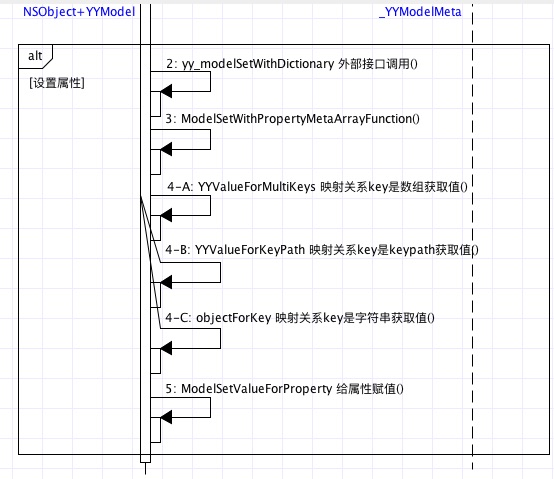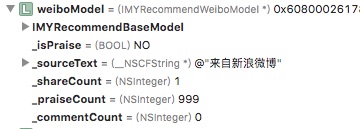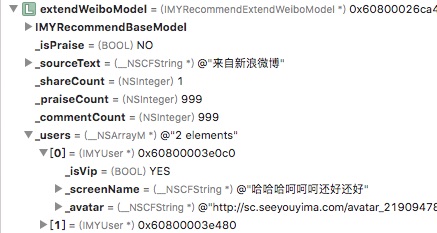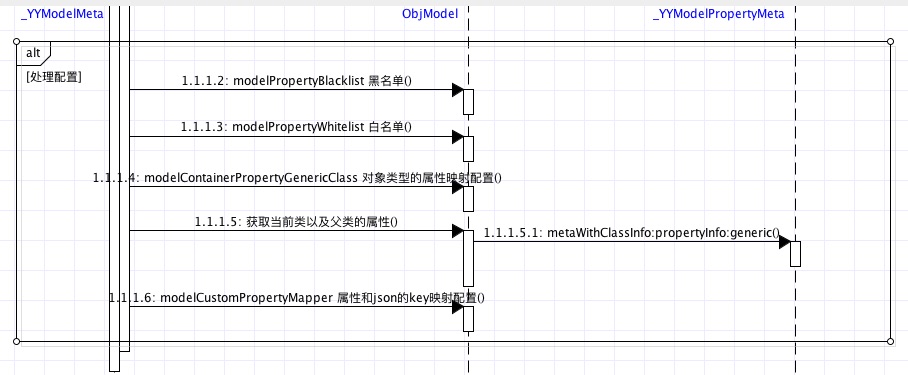阅读YYModel
YYModel库中涉及到Runtime、CF API、信号和锁、位的操作。学习该库可以学习到使用Runtime获取类的信息,包括:类属性信息、类ivar信息、类方法、类型编码;使用runtime底层技术进行方法调用,也就是objc_msgSend方法的使用;dispatch_semaphore_t信号锁的使用;CF框架中CFMutableDictionaryRef/CFMutableDictionaryRef对象的操作;位的操作。
- 简单使用介绍
- 简单的转化
- 自定义属性和json字段的映射配置
- 黑名单和白名单配置
- 类型映射配置
- 预备知识
- Type Encodings
- Property Type String
- 代码解析
- 类信息的获取
- 配置信息的获取
- 模型对象的转换
- 其它重要知识点
- 位操作
- 信号和锁
- CF框架API
YYModel使用介绍
首先会介绍下YYModel的使用,作为下面代码解析章节的铺垫,代码解析章节以使用方式作为入口点切入,研究框架整体的实现思路、步骤以及每个步骤使用的详细技术。
简单的转化
类属性的定义和json数据中的key是一致的,这种情况最为简单,不用配置映射关系,使用NSObject+YYModel的方法yy_modelWithDictionary获取yy_modelWithJSON即可以把数据反序列化为对象。
比如元素的JSON数据如下所示:
{
"id": 7975492,
"title": "同学们,开学了,准备好早起了吗?\n",
"source_text": "来自新浪微博",
"share_count": 1,
"praise_num": 999,
"comment_num": 0,
"is_praise": 0
}
定义的数据模型类如下:
@interface IMYOriginalRecommendWeiboModel : IMYRecommendBaseModel <YYModel>
@property (nonatomic, copy) NSString *source_text;
@property (nonatomic, assign) NSInteger share_count;
@property (nonatomic, assign) NSInteger praise_num; ///< 点赞数
@property (nonatomic, assign) BOOL is_praise; ///< 是否已点赞
@property (nonatomic, assign) NSInteger comment_num; ///< 评论数量
@end
转换后的结果如下:

自定义属性和json字段的映射配置
多数情况下,服务端的接口是为了多平台开发的,不同平台的属性定义标准、格式不一样,多数情况下我们需要把服务端的数据个数映射为平台适应的格式,这种情况需要用到配置自定义属性和json字段的映射,可以重写YYModel协议的方法modelCustomPropertyMapper返回一个配置。
定义的数据模型类如下:
@interface IMYOriginalRecommendWeiboModel : IMYRecommendBaseModel <YYModel>
@property (nonatomic, copy) NSString *sourceText;
@property (nonatomic, assign) NSInteger shareCount;
@property (nonatomic, assign) NSInteger praiseCount; ///< 点赞数
@property (nonatomic, assign) BOOL isPraise; ///< 是否已点赞
@property (nonatomic, assign) NSInteger commentCount; ///< 评论数量
@end
映射关系配置如下:
@implementation IMYRecommendWeiboModel
+ (NSDictionary *)modelCustomPropertyMapper {
return @{@"sourceText" : @"source_text",
@"shareCount" : @"share_count",
@"praiseCount" : @"praise_num",
@"isPraise" : @"is_praise",
@"commentCount" : @"comment_num",
};
}
@end
转换后的结果如下:

黑名单和白名单配置
黑名单配置如下:
@implementation IMYRecommendBlackListWeiboModel
+ (NSDictionary *)modelCustomPropertyMapper {
return @{@"sourceText" : @"source_text",
@"shareCount" : @"share_count",
@"praiseCount" : @"praise_num",
@"isPraise" : @"is_praise",
@"commentCount" : @"comment_num",
};
}
+ (NSArray<NSString *> *)modelPropertyBlacklist {
return @[@"sourceText", @"shareCount"];
}
@end
反序列化的结果,配置在黑名单中的属性(sourceText和shareCount)不会被赋值

白名单配置如下:
@implementation IMYRecommendWhiteListWeiboModel
+ (NSDictionary *)modelCustomPropertyMapper {
return @{@"sourceText" : @"source_text",
@"shareCount" : @"share_count",
@"praiseCount" : @"praise_num",
@"isPraise" : @"is_praise",
@"commentCount" : @"comment_num",
};
}
+ (NSArray<NSString *> *)modelPropertyWhitelist {
return @[@"sourceText", @"shareCount"];
}
@end
反序列化的结果,只有配置在白名单中的属性(sourceText和shareCount)才会被赋值

类型映射配置
类型映射配置用于属性是数组类型,需要配置该属性中元素的类类型,比如我们定义的数据模型如下,有个users指定是数组类型
@interface IMYRecommendExtendWeiboModel : IMYRecommendBaseModel <YYModel>
@property (nonatomic, copy) NSString *sourceText;
@property (nonatomic, assign) NSInteger shareCount;
@property (nonatomic, assign) NSInteger praiseCount; ///< 点赞数
@property (nonatomic, assign) BOOL isPraise; ///< 是否已点赞
@property (nonatomic, assign) NSInteger commentCount; ///< 评论数量
@property (nonatomic, strong) NSArray<IMYUser *> *users;
@end
类型映射配置如下:
@implementation IMYRecommendBlackListWeiboModel
+ (NSDictionary *)modelCustomPropertyMapper {
return @{@"sourceText" : @"source_text",
@"shareCount" : @"share_count",
@"praiseCount" : @"praise_num",
@"isPraise" : @"is_praise",
@"commentCount" : @"comment_num",
};
}
+ (NSDictionary *)modelContainerPropertyGenericClass {
return @{@"users" : [IMYUser class]};
}
@end
反序列化的结果如下:

预备知识
首先需要了解的是苹果对于类型说明的的一些规范,包括了Type Encodings和Property Type String,YYModel代码中重要的一部分就是对这些信息进行建模处理。
Type Encodings
Type Encodings 指的是属性、参数、变量的类型,比如基本数据类型有char、int、short、long、等;此外还有对象类型、类类型、数组类型、结构体类型、共用体类型、OC中的SEL类型等。其中Block 类型的比较特殊,该类型的的类型定义为:"@?",在YYModel中处理Block类型的代码如下:
case '@': {
if (len == 2 && *(type + 1) == '?')
return YYEncodingTypeBlock | qualifier;
else
return YYEncodingTypeObject | qualifier;
}
Property Type String
Property Type String 指的是property的内存属性、读写属性、原子属性、getter/getter属性、属性对应的ivar名称以及属性本身的Type Encoding,其中property的内存属性、读写属性、原子属性是只有属性名称,没有属性值,而property的getter/getter属性、属性对应的ivar名称以及属性本身的Type Encoding除了属性名称之外还会附加一个属性的值。查看property的属性名字和值可以使用property_getAttributes方法获取,返回的是一个const char *类型,如果需要对属性的名称和值进行详细的分析可以使用property_copyAttributeList获取到一个数组,数组的元素是objc_property_attribute_t这种结构体类型的,已经解析好了name和value,方便使用。
假设定义有如下的属性@property(getter=isIntReadOnlyGetter, readonly) int intReadonlyGetter; ,使用property_getAttributes方法获取到的属性对应的属性描述如下:Ti,R,GisIntReadOnlyGetter,intReadonlyGetter属性对应的objc_property_attribute_t类型为p,基本的规则解释如下:
- 类型 p.name == 'T',需要获取 p.value值,然后查询
Type Encodings表格 - 对应的ivar名称 p.name == 'V',需要获取 p.value值,p.value值为ivar名称
- 读写属性 p.name == 'R' -> readonly
- 内存属性 p.name == 'C' -> copy; p.name == '&' -> retain; p.name == 'W' -> weak
- 原子属性 p.name == 'N' -> nonatomic
- getter/setter属性 p.name = 'G<name>' -> G后面的内容为自定义的getter方法名称,使用p.value获取;p.name = 'S<name>' -> S后面的内容为自定义的setter方法名称,使用p.value获取
以下是一段使用property_getAttributes方法获取属性名字和值得示例代码
定义一个测试的类包含有如下几个属性
@interface MyObj : NSObject
@property (nonatomic, copy) MyBlock block;
@property struct YorkshireTeaStruct structDefault;
@property(nonatomic, readonly, retain) id idReadonlyRetainNonatomic;
@property(getter=isIntReadOnlyGetter, readonly) int intReadonlyGetter;
@end
使用如下的代码解析property的属性
char *propertyAttributes = (char *)property_getAttributes(property);
NSString *propertyAttributesString = [NSString stringWithUTF8String:propertyAttributes];
NSLog(@"propertyAttributesString = %@", propertyAttributesString);
使用以上的代码对MyObj类的属性进行分析,打印的内容如下,可以对照Property Type String和Type Encodings查看详细的说明:
propertyAttributesString = T@?,C,N,V_block
propertyAttributesString = T{YorkshireTeaStruct=ic},V_structDefault
propertyAttributesString = T@,R,&,N,V_idReadonlyRetainNonatomic
propertyAttributesString = Ti,R,GisIntReadOnlyGetter,V_intReadonlyGetter
代码解析
类信息的获取
类信息的获取主要是在YYClassInfo类的方法_update中处理的,包括类的类对象、父类的类对象、父类的类信息、是否是元类、属性信息、方法信息、ivar信息。实际上方法信息、ivar信息这两个信息并没有真正的使用到,但是框架中有进行处理,为了完整性还是稍作叙述。主要使用到的还是propertyInfos属性中的内容,后面的配置信息获取和模型对象转换都需要使用到。
YYClassInfo类的定义主要如下
@interface YYClassInfo : NSObject
@property (nonatomic, assign, readonly) Class cls; ///< class object
@property (nullable, nonatomic, assign, readonly) Class superCls; ///< super class object
@property (nullable, nonatomic, assign, readonly) Class metaCls; ///< class's meta class object
@property (nonatomic, readonly) BOOL isMeta; ///< whether this class is meta class
@property (nonatomic, strong, readonly) NSString *name; ///< class name
@property (nullable, nonatomic, strong, readonly) YYClassInfo *superClassInfo; ///< super class's class info
@property (nullable, nonatomic, strong, readonly) NSDictionary<NSString *, YYClassIvarInfo *> *ivarInfos; ///< ivars
@property (nullable, nonatomic, strong, readonly) NSDictionary<NSString *, YYClassMethodInfo *> *methodInfos; ///< methods
@property (nullable, nonatomic, strong, readonly) NSDictionary<NSString *, YYClassPropertyInfo *> *propertyInfos; ///< properties
// ...
流程时序图如下所示:

获取类信息的操作主要都在_update方法中,主要步骤如下
- class_copyMethodList 方法获取类中的方法信息,方法信息转换为YYClassMethodInfo对象,保存在methodInfos属性中
- class_copyPropertyList 方法获取类中的属性信息,属性信息转换为YYClassPropertyInfo对象,保存在propertyInfos属性中
- class_copyIvarList 方法获取类中的ivar信息,ivar信息转换为YYClassIvarInfo对象,保存在ivarInfos属性中
这里需要注意的是class_copyMethodList、class_copyPropertyList、class_copyIvarList涉及到内存的拷贝问题,使用完成之后需要使用C的方法free释放拷贝的内容,防止内存泄漏。上面有提到说方法信息、ivar信息这两个信息并没有真正的使用到,接下来会着重的介绍属性信息的获取中的一些细节。
- (void)_update {
_ivarInfos = nil;
_methodInfos = nil;
_propertyInfos = nil;
Class cls = self.cls;
// 获取类中的方法信息
unsigned int methodCount = 0;
Method *methods = class_copyMethodList(cls, &methodCount);
if (methods) {
NSMutableDictionary *methodInfos = [NSMutableDictionary new];
_methodInfos = methodInfos;
for (unsigned int i = 0; i < methodCount; i++) {
YYClassMethodInfo *info = [[YYClassMethodInfo alloc] initWithMethod:methods[i]];
if (info.name) methodInfos[info.name] = info;
}
free(methods);
}
// 获取类中的属性信息
unsigned int propertyCount = 0;
objc_property_t *properties = class_copyPropertyList(cls, &propertyCount);
if (properties) {
NSMutableDictionary *propertyInfos = [NSMutableDictionary new];
_propertyInfos = propertyInfos;
for (unsigned int i = 0; i < propertyCount; i++) {
YYClassPropertyInfo *info = [[YYClassPropertyInfo alloc] initWithProperty:properties[i]];
if (info.name) propertyInfos[info.name] = info;
}
free(properties);
}
// 获取类中的ivar信息
unsigned int ivarCount = 0;
Ivar *ivars = class_copyIvarList(cls, &ivarCount);
if (ivars) {
NSMutableDictionary *ivarInfos = [NSMutableDictionary new];
_ivarInfos = ivarInfos;
for (unsigned int i = 0; i < ivarCount; i++) {
YYClassIvarInfo *info = [[YYClassIvarInfo alloc] initWithIvar:ivars[i]];
if (info.name) ivarInfos[info.name] = info;
}
free(ivars);
}
if (!_ivarInfos) _ivarInfos = @{};
if (!_methodInfos) _methodInfos = @{};
if (!_propertyInfos) _propertyInfos = @{};
_needUpdate = NO;
}
属性信息获取
属性信息主要包含属性名字、属性的Encoding 类型、属性所属的类、属性的getter/setter方法的选择子SEL。这些信息会保存在属性信息类YYClassPropertyInfo中,属性信息类YYClassPropertyInfo定义如下:
@interface YYClassPropertyInfo : NSObject
@property (nonatomic, assign, readonly) objc_property_t property; ///< property's opaque struct
@property (nonatomic, strong, readonly) NSString *name; ///< property's name
@property (nonatomic, assign, readonly) YYEncodingType type; ///< property's type
@property (nonatomic, strong, readonly) NSString *typeEncoding; ///< property's encoding value
@property (nonatomic, strong, readonly) NSString *ivarName; ///< property's ivar name
@property (nullable, nonatomic, assign, readonly) Class cls; ///< may be nil
@property (nullable, nonatomic, strong, readonly) NSArray<NSString *> *protocols; ///< may nil
@property (nonatomic, assign, readonly) SEL getter; ///< getter (nonnull)
@property (nonatomic, assign, readonly) SEL setter; ///< setter (nonnull)
// ...
属性处理主要在initWithProperty方法中进行,这部分的内容在前面的预备知识中的Type Encodings和Property Type String有讲到了大部分,主要步骤如下:
- 获取property名字
- 读取property的属性名字和属性值,建立属性的Encoding模型
- 处理getter/setter
- (instancetype)initWithProperty:(objc_property_t)property {
if (!property) return nil;
self = [super init];
_property = property;
// 获取property名字
const char *name = property_getName(property);
if (name) {
_name = [NSString stringWithUTF8String:name];
}
// 读取property的属性名字和属性值,建立属性的Encoding模型
YYEncodingType type = 0;
unsigned int attrCount;
objc_property_attribute_t *attrs = property_copyAttributeList(property, &attrCount);
for (unsigned int i = 0; i < attrCount; i++) {
switch (attrs[i].name[0]) {
case 'T': { // Type encoding
if (attrs[i].value) {
_typeEncoding = [NSString stringWithUTF8String:attrs[i].value];
type = YYEncodingGetType(attrs[i].value);
if ((type & YYEncodingTypeMask) == YYEncodingTypeObject && _typeEncoding.length) {
NSScanner *scanner = [NSScanner scannerWithString:_typeEncoding];
if (![scanner scanString:@"@\"" intoString:NULL]) continue;
NSString *clsName = nil;
if ([scanner scanUpToCharactersFromSet: [NSCharacterSet characterSetWithCharactersInString:@"\"<"] intoString:&clsName]) {
if (clsName.length) _cls = objc_getClass(clsName.UTF8String);
}
NSMutableArray *protocols = nil;
while ([scanner scanString:@"<" intoString:NULL]) {
NSString* protocol = nil;
if ([scanner scanUpToString:@">" intoString: &protocol]) {
if (protocol.length) {
if (!protocols) protocols = [NSMutableArray new];
[protocols addObject:protocol];
}
}
[scanner scanString:@">" intoString:NULL];
}
_protocols = protocols;
}
}
} break;
case 'V': { // Instance variable
if (attrs[i].value) {
_ivarName = [NSString stringWithUTF8String:attrs[i].value];
}
} break;
case 'R': {
type |= YYEncodingTypePropertyReadonly;
} break;
case 'C': {
type |= YYEncodingTypePropertyCopy;
} break;
case '&': {
type |= YYEncodingTypePropertyRetain;
} break;
case 'N': {
type |= YYEncodingTypePropertyNonatomic;
} break;
case 'D': {
type |= YYEncodingTypePropertyDynamic;
} break;
case 'W': {
type |= YYEncodingTypePropertyWeak;
} break;
case 'G': {
type |= YYEncodingTypePropertyCustomGetter;
if (attrs[i].value) {
_getter = NSSelectorFromString([NSString stringWithUTF8String:attrs[i].value]);
}
} break;
case 'S': {
type |= YYEncodingTypePropertyCustomSetter;
if (attrs[i].value) {
_setter = NSSelectorFromString([NSString stringWithUTF8String:attrs[i].value]);
}
} // break; commented for code coverage in next line
default: break;
}
}
if (attrs) {
free(attrs);
attrs = NULL;
}
_type = type;
// 处理getter、setter方法
if (_name.length) {
if (!_getter) {
_getter = NSSelectorFromString(_name);
}
if (!_setter) {
_setter = NSSelectorFromString([NSString stringWithFormat:@"set%@%@:", [_name substringToIndex:1].uppercaseString, [_name substringFromIndex:1]]);
}
}
return self;
}
配置信息的获取
配置信息的获取主要流程时序图如下:

主要有以下几个步骤:
- 黑名单配置获取
- 白名单配置获取
- 容器类型中元素类型配置获取
- 递归遍历当前类和父类的propertyInfos属性,获取所有property的元数据
- 处理自定义的属性对于json数据key的映射配置
对应的代码如下,关键的地方有添加了注释:
- (instancetype)initWithClass:(Class)cls {
YYClassInfo *classInfo = [YYClassInfo classInfoWithClass:cls];
if (!classInfo) return nil;
self = [super init];
// Get black list
// 黑名单配置获取
NSSet *blacklist = nil;
if ([cls respondsToSelector:@selector(modelPropertyBlacklist)]) {
NSArray *properties = [(id<YYModel>)cls modelPropertyBlacklist];
if (properties) {
blacklist = [NSSet setWithArray:properties];
}
}
// Get white list
// 白名单配置获取
NSSet *whitelist = nil;
if ([cls respondsToSelector:@selector(modelPropertyWhitelist)]) {
NSArray *properties = [(id<YYModel>)cls modelPropertyWhitelist];
if (properties) {
whitelist = [NSSet setWithArray:properties];
}
}
// Get container property's generic class
// 容器类型中元素类型配置获取
NSDictionary *genericMapper = nil;
if ([cls respondsToSelector:@selector(modelContainerPropertyGenericClass)]) {
genericMapper = [(id<YYModel>)cls modelContainerPropertyGenericClass];
if (genericMapper) {
NSMutableDictionary *tmp = [NSMutableDictionary new];
[genericMapper enumerateKeysAndObjectsUsingBlock:^(id key, id obj, BOOL *stop) {
if (![key isKindOfClass:[NSString class]]) return;
Class meta = object_getClass(obj);
if (!meta) return;
if (class_isMetaClass(meta)) {
tmp[key] = obj;
} else if ([obj isKindOfClass:[NSString class]]) {
Class cls = NSClassFromString(obj);
if (cls) {
tmp[key] = cls;
}
}
}];
genericMapper = tmp;
}
}
// 递归遍历当前类和父类的propertyInfos属性,获取所有property的元数据
// property的元数据对应的私有类为_YYModelPropertyMeta,其实就是YYClassPropertyInfo类对象的封装
NSMutableDictionary *allPropertyMetas = [NSMutableDictionary new];
YYClassInfo *curClassInfo = classInfo;
while (curClassInfo && curClassInfo.superCls != nil) { // recursive parse super class, but ignore root class (NSObject/NSProxy)
for (YYClassPropertyInfo *propertyInfo in curClassInfo.propertyInfos.allValues) {
if (!propertyInfo.name) continue;
if (blacklist && [blacklist containsObject:propertyInfo.name]) continue;
if (whitelist && ![whitelist containsObject:propertyInfo.name]) continue;
_YYModelPropertyMeta *meta = [_YYModelPropertyMeta metaWithClassInfo:classInfo
propertyInfo:propertyInfo
generic:genericMapper[propertyInfo.name]];
if (!meta || !meta->_name) continue;
if (!meta->_getter || !meta->_setter) continue;
if (allPropertyMetas[meta->_name]) continue;
allPropertyMetas[meta->_name] = meta;
}
curClassInfo = curClassInfo.superClassInfo;
}
if (allPropertyMetas.count) _allPropertyMetas = allPropertyMetas.allValues.copy;
// create mapper
// 处理自定义的属性对于json数据key的映射配置
NSMutableDictionary *mapper = [NSMutableDictionary new];
NSMutableArray *keyPathPropertyMetas = [NSMutableArray new];
NSMutableArray *multiKeysPropertyMetas = [NSMutableArray new];
if ([cls respondsToSelector:@selector(modelCustomPropertyMapper)]) {
NSDictionary *customMapper = [(id <YYModel>)cls modelCustomPropertyMapper];
[customMapper enumerateKeysAndObjectsUsingBlock:^(NSString *propertyName, NSString *mappedToKey, BOOL *stop) {
_YYModelPropertyMeta *propertyMeta = allPropertyMetas[propertyName];
if (!propertyMeta) return;
[allPropertyMetas removeObjectForKey:propertyName];
if ([mappedToKey isKindOfClass:[NSString class]]) {
if (mappedToKey.length == 0) return;
propertyMeta->_mappedToKey = mappedToKey;
NSArray *keyPath = [mappedToKey componentsSeparatedByString:@"."];
for (NSString *onePath in keyPath) {
if (onePath.length == 0) {
NSMutableArray *tmp = keyPath.mutableCopy;
[tmp removeObject:@""];
keyPath = tmp;
break;
}
}
if (keyPath.count > 1) {
propertyMeta->_mappedToKeyPath = keyPath;
[keyPathPropertyMetas addObject:propertyMeta];
}
// 处理有多个属性绑定到同一个json数据key的配置
propertyMeta->_next = mapper[mappedToKey] ?: nil;
mapper[mappedToKey] = propertyMeta;
} else if ([mappedToKey isKindOfClass:[NSArray class]]) {
NSMutableArray *mappedToKeyArray = [NSMutableArray new];
for (NSString *oneKey in ((NSArray *)mappedToKey)) {
if (![oneKey isKindOfClass:[NSString class]]) continue;
if (oneKey.length == 0) continue;
NSArray *keyPath = [oneKey componentsSeparatedByString:@"."];
if (keyPath.count > 1) {
[mappedToKeyArray addObject:keyPath];
} else {
[mappedToKeyArray addObject:oneKey];
}
if (!propertyMeta->_mappedToKey) {
propertyMeta->_mappedToKey = oneKey;
propertyMeta->_mappedToKeyPath = keyPath.count > 1 ? keyPath : nil;
}
}
if (!propertyMeta->_mappedToKey) return;
propertyMeta->_mappedToKeyArray = mappedToKeyArray;
[multiKeysPropertyMetas addObject:propertyMeta];
// 处理有多个属性绑定到同一个json数据key的配置
propertyMeta->_next = mapper[mappedToKey] ?: nil;
mapper[mappedToKey] = propertyMeta;
}
}];
}
// 处理默认的属性的映射配置,属性在json数据中的key就是属性的原始名称
[allPropertyMetas enumerateKeysAndObjectsUsingBlock:^(NSString *name, _YYModelPropertyMeta *propertyMeta, BOOL *stop) {
propertyMeta->_mappedToKey = name;
propertyMeta->_next = mapper[name] ?: nil;
mapper[name] = propertyMeta;
}];
// 最终把json数据key和属性的映射关系保存起来
if (mapper.count) _mapper = mapper;
if (keyPathPropertyMetas) _keyPathPropertyMetas = keyPathPropertyMetas;
if (multiKeysPropertyMetas) _multiKeysPropertyMetas = multiKeysPropertyMetas;
_classInfo = classInfo;
_keyMappedCount = _allPropertyMetas.count;
_nsType = YYClassGetNSType(cls);
_hasCustomWillTransformFromDictionary = ([cls instancesRespondToSelector:@selector(modelCustomWillTransformFromDictionary:)]);
_hasCustomTransformFromDictionary = ([cls instancesRespondToSelector:@selector(modelCustomTransformFromDictionary:)]);
_hasCustomTransformToDictionary = ([cls instancesRespondToSelector:@selector(modelCustomTransformToDictionary:)]);
_hasCustomClassFromDictionary = ([cls respondsToSelector:@selector(modelCustomClassForDictionary:)]);
return self;
}
模型对象的转换
模型对象的转换的步骤时序图如下:

入口函数yy_modelSetWithDictionary的功能如下:
- 1、属性的映射配置的个数大于json数据元素的个数(if分支),优先处理json数据
- 1.1、遍历json数据的key
- 1.2、根据key从
meta->_mapper配置中寻找映射的_YYModelPropertyMeta对象 - 1.3、从json数据中读取值,给属性设置值。
- 2、json数据元素的个数大于属性的映射配置的个数(else分支),优先处理属性属性
- 2.1、从
modelMeta->_allPropertyMetas读取属性配置 - 2.2、从json数据中读取值,给属性设置值
- 2.1、从
对应的代码如下,关键的地方有添加了注释:
- (BOOL)yy_modelSetWithDictionary:(NSDictionary *)dic {
if (!dic || dic == (id)kCFNull) return NO;
if (![dic isKindOfClass:[NSDictionary class]]) return NO;
_YYModelMeta *modelMeta = [_YYModelMeta metaWithClass:object_getClass(self)];
if (modelMeta->_keyMappedCount == 0) return NO;
if (modelMeta->_hasCustomWillTransformFromDictionary) {
dic = [((id<YYModel>)self) modelCustomWillTransformFromDictionary:dic];
if (![dic isKindOfClass:[NSDictionary class]]) return NO;
}
ModelSetContext context = {0};
context.modelMeta = (__bridge void *)(modelMeta);
context.model = (__bridge void *)(self);
context.dictionary = (__bridge void *)(dic);
// 这里做这个处理主要是为了优化性能,哪个少优先处理哪个,提高效率
// 1、属性的映射配置的个数大于json数据元素的个数(if分支),优先处理json数据
// 1.1、遍历json数据的key
// 1.2、根据key从`meta->_mapper`配置中寻找映射的`_YYModelPropertyMeta`对象
// 1.3、从json数据中读取值,给属性设置值。
// * 因为`meta->_mapper`保存的是一对一的映射关系,所以另外需要额外的处理keypath映射和数组类型的key的映射
// 2、json数据元素的个数大于属性的映射配置的个数(else分支),优先处理属性属性
// 2.1、从`modelMeta->_allPropertyMetas`读取属性配置
// 2.2、从json数据中读取值,给属性设置值
if (modelMeta->_keyMappedCount >= CFDictionaryGetCount((CFDictionaryRef)dic)) {
// 处理多个属性映射到同一个json数据的key
CFDictionaryApplyFunction((CFDictionaryRef)dic, ModelSetWithDictionaryFunction, &context);
if (modelMeta->_keyPathPropertyMetas) {
// 处理keypath,属性对应json数据key是多层类型的映射
CFArrayApplyFunction((CFArrayRef)modelMeta->_keyPathPropertyMetas,
CFRangeMake(0, CFArrayGetCount((CFArrayRef)modelMeta->_keyPathPropertyMetas)),
ModelSetWithPropertyMetaArrayFunction,
&context);
}
if (modelMeta->_multiKeysPropertyMetas) {
// 处理数组类型映射,属性对应json数据key是多个的映射
CFArrayApplyFunction((CFArrayRef)modelMeta->_multiKeysPropertyMetas,
CFRangeMake(0, CFArrayGetCount((CFArrayRef)modelMeta->_multiKeysPropertyMetas)),
ModelSetWithPropertyMetaArrayFunction,
&context);
}
} else {
// 处理属性多json数据的key的一对一映射,这种情况多个属性映射到同一个json数据的key处理方式和ModelSetWithDictionaryFunction方法的不一样,不过最终的结果是一样的
CFArrayApplyFunction((CFArrayRef)modelMeta->_allPropertyMetas,
CFRangeMake(0, modelMeta->_keyMappedCount),
ModelSetWithPropertyMetaArrayFunction,
&context);
}
if (modelMeta->_hasCustomTransformFromDictionary) {
return [((id<YYModel>)self) modelCustomTransformFromDictionary:dic];
}
return YES;
}
以上代码中使用到的两个方法ModelSetWithDictionaryFunction、ModelSetWithPropertyMetaArrayFunction,这两个方法很简单,使用获取值方法YYValueForMultiKeys、YYValueForKeyPath,根据_YYModelPropertyMeta对象的配置从json数据中获取值,然后调用ModelSetValueForProperty给对象的属性设置值。
static void ModelSetWithDictionaryFunction(const void *_key, const void *_value, void *_context) {
ModelSetContext *context = _context;
__unsafe_unretained _YYModelMeta *meta = (__bridge _YYModelMeta *)(context->modelMeta);
__unsafe_unretained _YYModelPropertyMeta *propertyMeta = [meta->_mapper objectForKey:(__bridge id)(_key)];
__unsafe_unretained id model = (__bridge id)(context->model);
while (propertyMeta) {
if (propertyMeta->_setter) {
ModelSetValueForProperty(model, (__bridge __unsafe_unretained id)_value, propertyMeta);
}
propertyMeta = propertyMeta->_next;
};
}
static void ModelSetWithPropertyMetaArrayFunction(const void *_propertyMeta, void *_context) {
ModelSetContext *context = _context;
__unsafe_unretained NSDictionary *dictionary = (__bridge NSDictionary *)(context->dictionary);
__unsafe_unretained _YYModelPropertyMeta *propertyMeta = (__bridge _YYModelPropertyMeta *)(_propertyMeta);
if (!propertyMeta->_setter) return;
id value = nil;
if (propertyMeta->_mappedToKeyArray) {
value = YYValueForMultiKeys(dictionary, propertyMeta->_mappedToKeyArray);
} else if (propertyMeta->_mappedToKeyPath) {
value = YYValueForKeyPath(dictionary, propertyMeta->_mappedToKeyPath);
} else {
value = [dictionary objectForKey:propertyMeta->_mappedToKey];
}
if (value) {
__unsafe_unretained id model = (__bridge id)(context->model);
ModelSetValueForProperty(model, value, propertyMeta);
}
}
获取值方法YYValueForMultiKeys、YYValueForKeyPath也比较简单
YYValueForMultiKeys深度遍历json数据取值YYValueForKeyPath广度遍历json数据取值
static force_inline id YYValueForKeyPath(__unsafe_unretained NSDictionary *dic, __unsafe_unretained NSArray *keyPaths) {
id value = nil;
for (NSUInteger i = 0, max = keyPaths.count; i < max; i++) {
value = dic[keyPaths[i]];
if (i + 1 < max) {
if ([value isKindOfClass:[NSDictionary class]]) {
dic = value;
} else {
return nil;
}
}
}
return value;
}
static force_inline id YYValueForMultiKeys(__unsafe_unretained NSDictionary *dic, __unsafe_unretained NSArray *multiKeys) {
id value = nil;
for (NSString *key in multiKeys) {
if ([key isKindOfClass:[NSString class]]) {
value = dic[key];
if (value) break;
} else {
value = YYValueForKeyPath(dic, (NSArray *)key);
if (value) break;
}
}
return value;
}
到了最关键的设置属性值的方法ModelSetValueForProperty,使用底层的C语言方法objc_msgSend给属性赋值,该方法区分类型处理值
- 数值类型
- NSFoundation类型,包含了NSArray、NSString、NSDictionary、NSData等类型以及对应的可变类型(如果存在)
- 其余特殊类型,包含了SEL、block、Struct、Union、C指针、字符串指针等
需要注意:
- 1、可变类型需要特殊处理,需要使用mutableCopy复制一个可变对象赋值给属性,否则使用可变类型的特有api比如addObject就会出现崩溃;
- 2、json数据取出的值和property定义的值类型可能不一样,如果是数值类型,需要把数值转换为对应类型,否则编译不过;如果是NSFoundation类型,需要把Json数据转换为property定义的类型,否则类型会有问题,方法
objc_msgSend可以设置成功,比如property中定义的是属性status_desc是NSString类型,方法objc_msgSend方法的参数传递的是一个NSDate类型,使用status_desc的方法比如length就会崩溃,因为类型变为NSDate了,在NSDate中找不到length方法
方法的部分如下:
static void ModelSetValueForProperty(__unsafe_unretained id model,
__unsafe_unretained id value,
__unsafe_unretained _YYModelPropertyMeta *meta) {
if (meta->_isCNumber) {
NSNumber *num = YYNSNumberCreateFromID(value);
ModelSetNumberToProperty(model, num, meta);
if (num) [num class]; // hold the number
} else if (meta->_nsType) {
if (value == (id)kCFNull) {
((void (*)(id, SEL, id))(void *) objc_msgSend)((id)model, meta->_setter, (id)nil);
} else {
switch (meta->_nsType) {
case YYEncodingTypeNSString:
case YYEncodingTypeNSMutableString: {
if ([value isKindOfClass:[NSString class]]) {
if (meta->_nsType == YYEncodingTypeNSString) {
((void (*)(id, SEL, id))(void *) objc_msgSend)((id)model, meta->_setter, value);
} else {
((void (*)(id, SEL, id))(void *) objc_msgSend)((id)model, meta->_setter, ((NSString *)value).mutableCopy);
}
} else if ([value isKindOfClass:[NSNumber class]]) {
((void (*)(id, SEL, id))(void *) objc_msgSend)((id)model,
meta->_setter,
(meta->_nsType == YYEncodingTypeNSString) ?
((NSNumber *)value).stringValue :
((NSNumber *)value).stringValue.mutableCopy);
} else if ([value isKindOfClass:[NSData class]]) {
NSMutableString *string = [[NSMutableString alloc] initWithData:value encoding:NSUTF8StringEncoding];
((void (*)(id, SEL, id))(void *) objc_msgSend)((id)model, meta->_setter, string);
} else if ([value isKindOfClass:[NSURL class]]) {
((void (*)(id, SEL, id))(void *) objc_msgSend)((id)model,
meta->_setter,
(meta->_nsType == YYEncodingTypeNSString) ?
((NSURL *)value).absoluteString :
((NSURL *)value).absoluteString.mutableCopy);
} else if ([value isKindOfClass:[NSAttributedString class]]) {
((void (*)(id, SEL, id))(void *) objc_msgSend)((id)model,
meta->_setter,
(meta->_nsType == YYEncodingTypeNSString) ?
((NSAttributedString *)value).string :
((NSAttributedString *)value).string.mutableCopy);
}
} break;
// ... 省略很多
default: break;
}
}
} else {
BOOL isNull = (value == (id)kCFNull);
switch (meta->_type & YYEncodingTypeMask) {
case YYEncodingTypeObject: {
if (isNull) {
((void (*)(id, SEL, id))(void *) objc_msgSend)((id)model, meta->_setter, (id)nil);
} else if ([value isKindOfClass:meta->_cls] || !meta->_cls) {
((void (*)(id, SEL, id))(void *) objc_msgSend)((id)model, meta->_setter, (id)value);
} else if ([value isKindOfClass:[NSDictionary class]]) {
NSObject *one = nil;
if (meta->_getter) {
one = ((id (*)(id, SEL))(void *) objc_msgSend)((id)model, meta->_getter);
}
if (one) {
[one yy_modelSetWithDictionary:value];
} else {
Class cls = meta->_cls;
if (meta->_hasCustomClassFromDictionary) {
cls = [cls modelCustomClassForDictionary:value];
if (!cls) cls = meta->_genericCls; // for xcode code coverage
}
one = [cls new];
[one yy_modelSetWithDictionary:value];
((void (*)(id, SEL, id))(void *) objc_msgSend)((id)model, meta->_setter, (id)one);
}
}
} break;
case YYEncodingTypeClass: {
if (isNull) {
((void (*)(id, SEL, Class))(void *) objc_msgSend)((id)model, meta->_setter, (Class)NULL);
} else {
Class cls = nil;
if ([value isKindOfClass:[NSString class]]) {
cls = NSClassFromString(value);
if (cls) {
((void (*)(id, SEL, Class))(void *) objc_msgSend)((id)model, meta->_setter, (Class)cls);
}
} else {
cls = object_getClass(value);
if (cls) {
if (class_isMetaClass(cls)) {
((void (*)(id, SEL, Class))(void *) objc_msgSend)((id)model, meta->_setter, (Class)value);
}
}
}
}
} break;
case YYEncodingTypeSEL: {
if (isNull) {
((void (*)(id, SEL, SEL))(void *) objc_msgSend)((id)model, meta->_setter, (SEL)NULL);
} else if ([value isKindOfClass:[NSString class]]) {
SEL sel = NSSelectorFromString(value);
if (sel) ((void (*)(id, SEL, SEL))(void *) objc_msgSend)((id)model, meta->_setter, (SEL)sel);
}
} break;
case YYEncodingTypeBlock: {
if (isNull) {
((void (*)(id, SEL, void (^)()))(void *) objc_msgSend)((id)model, meta->_setter, (void (^)())NULL);
} else if ([value isKindOfClass:YYNSBlockClass()]) {
((void (*)(id, SEL, void (^)()))(void *) objc_msgSend)((id)model, meta->_setter, (void (^)())value);
}
} break;
case YYEncodingTypeStruct:
case YYEncodingTypeUnion:
case YYEncodingTypeCArray: {
if ([value isKindOfClass:[NSValue class]]) {
const char *valueType = ((NSValue *)value).objCType;
const char *metaType = meta->_info.typeEncoding.UTF8String;
if (valueType && metaType && strcmp(valueType, metaType) == 0) {
[model setValue:value forKey:meta->_name];
}
}
} break;
case YYEncodingTypePointer:
case YYEncodingTypeCString: {
if (isNull) {
((void (*)(id, SEL, void *))(void *) objc_msgSend)((id)model, meta->_setter, (void *)NULL);
} else if ([value isKindOfClass:[NSValue class]]) {
NSValue *nsValue = value;
if (nsValue.objCType && strcmp(nsValue.objCType, "^v") == 0) {
((void (*)(id, SEL, void *))(void *) objc_msgSend)((id)model, meta->_setter, nsValue.pointerValue);
}
}
} // break; commented for code coverage in next line
default: break;
}
}
}
其它重要知识点
位操作
YYModel框架中定义了一个枚举YYEncodingType,这个类型的值可以保存property的值类型(Type Encoding);property的读写、原子、内存等属性(Property Encoding);方法的类型(Method Encoding)(暂时没用到)。在获取类型方法YYEncodingGetType获取类型的时候使用位活操作符"|"组合多个Encoding,在设置属性值的方法比如ModelSetNumberToProperty,使用位与操作符“&”判断是否是特定的类型。使用这种类型有两个好处:1、节省空间;2、位操作效率比较高,比如乘除2,使用左移或者右移的效率会比乘除法高,不过实际编码中为了可读性还是最好使用乘除法,另外现代的编译器会帮我们做很多优化,在绝大多数的场景中,我们可以不用太关注这些细枝末节,真正需要优化的时候才考虑做这类代码上的优化。
信号和锁
YYModel中使用的是信号锁dispatch_semaphore_t,为什么使用这种类型的锁呢,可以从作者的博客中找到答案不再安全的 OSSpinLock ,这种锁的效率还是非常高的,又可以避免OSSpinLock锁产生的问题。这个场景中dispatch_semaphore_t是一个读写互斥锁,CFDictionaryGetValue是读操作,CFDictionarySetValue是写操作,这两者同一时间只能一个进入,其余的需要等待。
+ (instancetype)metaWithClass:(Class)cls {
if (!cls) return nil;
static CFMutableDictionaryRef cache;
static dispatch_once_t onceToken;
static dispatch_semaphore_t lock;
dispatch_once(&onceToken, ^{
cache = CFDictionaryCreateMutable(CFAllocatorGetDefault(), 0, &kCFTypeDictionaryKeyCallBacks, &kCFTypeDictionaryValueCallBacks);
lock = dispatch_semaphore_create(1);
});
dispatch_semaphore_wait(lock, DISPATCH_TIME_FOREVER);
_YYModelMeta *meta = CFDictionaryGetValue(cache, (__bridge const void *)(cls));
dispatch_semaphore_signal(lock);
if (!meta || meta->_classInfo.needUpdate) {
meta = [[_YYModelMeta alloc] initWithClass:cls];
if (meta) {
dispatch_semaphore_wait(lock, DISPATCH_TIME_FOREVER);
CFDictionarySetValue(cache, (__bridge const void *)(cls), (__bridge const void *)(meta));
dispatch_semaphore_signal(lock);
}
}
return meta;
}
CF框架API
yy_modelSetWithDictionary方法中使用到CF框架中容器遍历的API有CFDictionaryApplyFunction和CFArrayApplyFunction,一般滴使用CF框架的API性能会高于NSFoundation框架的API,因为NSFoundation框架的API是基于CF框架的API,此时NSFoundation框架相当于一个中间者,绕了一步。更多的关于CFArray的知识可以参考Exposing NSMutableArray这篇文章的介绍。











